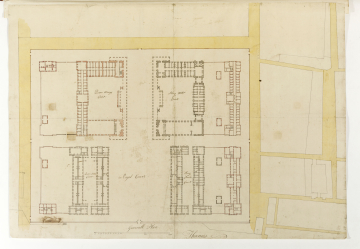
Browse
Reference number
Purpose
Aspect
Scale
Inscribed
Signed and dated
- Undated but datable c.1735.
Medium and dimensions
Hand
Watermark
Notes
The two ranges behind the King William and King Charles Courts are additions to the scheme in [12/6]. The range behind King William Court provides beds for another 150 men, and all the rooms are provided with hearths, indicating accommodation for higher status veterans and invalids, or for officers. The range behind King Charles Court was probably intended as the infirmary, as it is not laid out with cubicles but with larger gallery and hall-like spaces.
The drawing is in the same hand as another plan from this period, NMM ART 3/4 (Bold 2000, fig. 207). The latter does not have the rear ranges on the west side and the houses at the north and south ends of the east courtyards, but it indicates that the infirmary will be in a street block immediately west of the southern half of the site ('Ground reserved for an Infirmary').
Literature
Level
Sir John Soane's collection includes some 30,000 architectural, design and topographical drawings which is a very important resource for scholars worldwide. His was the first architect’s collection to attempt to preserve the best in design for the architectural profession in the future, and it did so by assembling as exemplars surviving drawings by great Renaissance masters and by the leading architects in Britain in the 17th and 18th centuries and his near contemporaries such as Sir William Chambers, Robert Adam and George Dance the Younger. These drawings sit side by side with 9,000 drawings in Soane’s own hand or those of the pupils in his office, covering his early work as a student, his time in Italy and the drawings produced in the course of his architectural practice from 1780 until the 1830s.
Browse (via the vertical menu to the left) and search results for Drawings include a mixture of Concise catalogue records – drawn from an outline list of the collection – and fuller records where drawings have been catalogued in more detail (an ongoing process).

